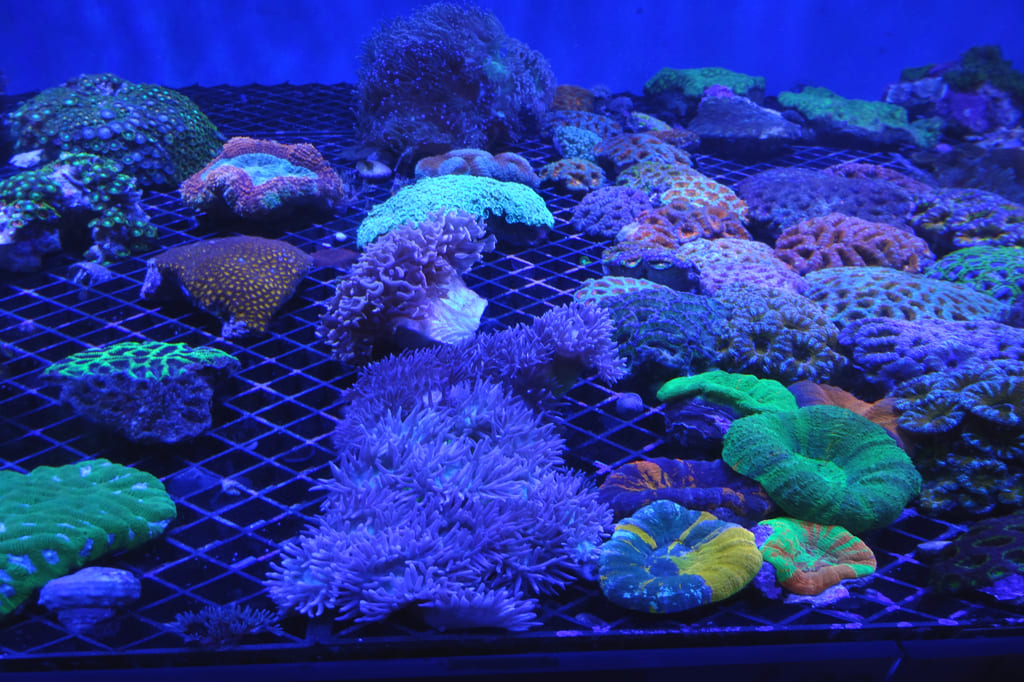Did you know that coral reefs are home to approximately 25% of marine species though they only cover 1% of the ocean floor1https://www.fisheries.noaa.gov/national/habitat-conservation/shallow-coral-reef-habitat? The largest coral reef in the world is the Great Barrier Reef which covers 133,000 square miles off the coast of Australia. The next largest reef is the New Caledonia Barrier Reef which only covers 9,300 square miles, followed by the Belize Barrier Reef which covers 370 square miles. Corals are crucial to providing biodiversity in marine ecosystems through creating habitats for fish and shellfish. They also play a key role in protecting island coasts from erosion and sequestering carbon dioxide from the atmosphere.
Global coral cover has declined by about 50% since the 1950’s primarily due to rising sea temperatures that put stress on the coral causing coral bleaching. Many countries and non-governmental organizations with reef systems are investing in reef propagation programs to restore these fragile ecosystems. This is happening worldwide in the Maldives, Bonaire, Puerto Rico, and the Great Barrier Reef to name a few locations. Similar to how you can propagate a snippet of a plant to grow a new plant, reef propagation involves collecting and regenerating healthy fragments of corals to create new, beautiful coral colonies.
This typically starts by selecting a site that is suited for propagation. Suitable sites will have stable environmental conditions as well as ideal sunlight exposure and wave energy for the particular coral species that is being propagated. Corals should be propagated in locations that are close to healthy reefs for connectivity but are also close to the scientists that will be monitoring and maintaining the restoration efforts.
Coral nurseries are started to grow coral under controlled conditions. This might involve attaching coral to propagation units like concrete structures or pipes to monitor their growth. Depending on the species of coral, propagation can take months before reaching the size suitable for transplant. Branching corals are commonly propagated because they tend to grow faster than massive corals, though both are suitable for propagation. Table and plating corals, which tend to have flat growth forms, are also often propagated, as well as with endangered corals like staghorn and elkhorn corals.
Once coral fragments have reached a suitable size, they are transplanted onto degraded reef sites. Corals may be attached to the reef substrate using adhesives, cement, or other materials to promote attachment and growth.
Then, ongoing monitoring and maintenance are essential to assess the success of reef propagation efforts. Scientists will track coral growth and survival rates, and identify potential threats or challenges that may hinder successful coral regrowth. Monitoring involves regular surveys of coral health, growth and biodiversity.
Though coral propagation can help with conservation and resiliency in degraded reefs, it does not solve the root cause of reefs under stress from man-made climate change, ocean-acidification and pollution. Long-term reef conservation efforts must focus on reducing stressors from greenhouse gas emissions and human activity. Community engagement is key to protect critical marine areas and ensure that development along coastlines is sustainable and non-intrusive to marine wildlife.
Though there are hundreds of emission-reducing actions you can make in your daily life to help save the corals, here are a few tips to make a direct impact:
- Boat sustainably: If you’re taking a boat out on vacation, avoid anchoring on a reef. When at sea, strap down loose items so they don’t fly overboard, and collect all trash to bring to shore. Ensure that your boat is properly maintained to avoid fuel or chemical spills in the water.
- Coral reef etiquette: Avoid touching coral or stirring up sediment on the ground when you snorkel or dive. Never step on a coral and strive to maintain a horizontal position when close to reefs so you don’t accidentally touch corals below you. It’s better to keep a slight distance from the reef than to accidentally disturb a habitat.
- Sunscreen: Use reef-safe, mineral-based sunscreen when going in the ocean. Reef-safe sunscreens utilize ingredients like titanium dioxide and zinc oxide which are physical blockers rather than chemicals like oxybenzone and octinoxate. Or, wear protective clothing to reduce the need for sunscreen altogether.
- Eat sustainable seafood: Many fish species like grouper, snapper, and lobster, depend on healthy coral reefs for food and shelter. Therefore, it’s important to eat seafood that was sourced sustainably. Focus on finding seafood that was caught in the wild in a way that protects the long-term health of animal populations and ecosystems.
- Volunteer: Next time you go to the coast for vacation, sign up for a coral restoration activity at the local aquarium or nonprofit organization!
Keywords: #Vacation #Marine life #Food
